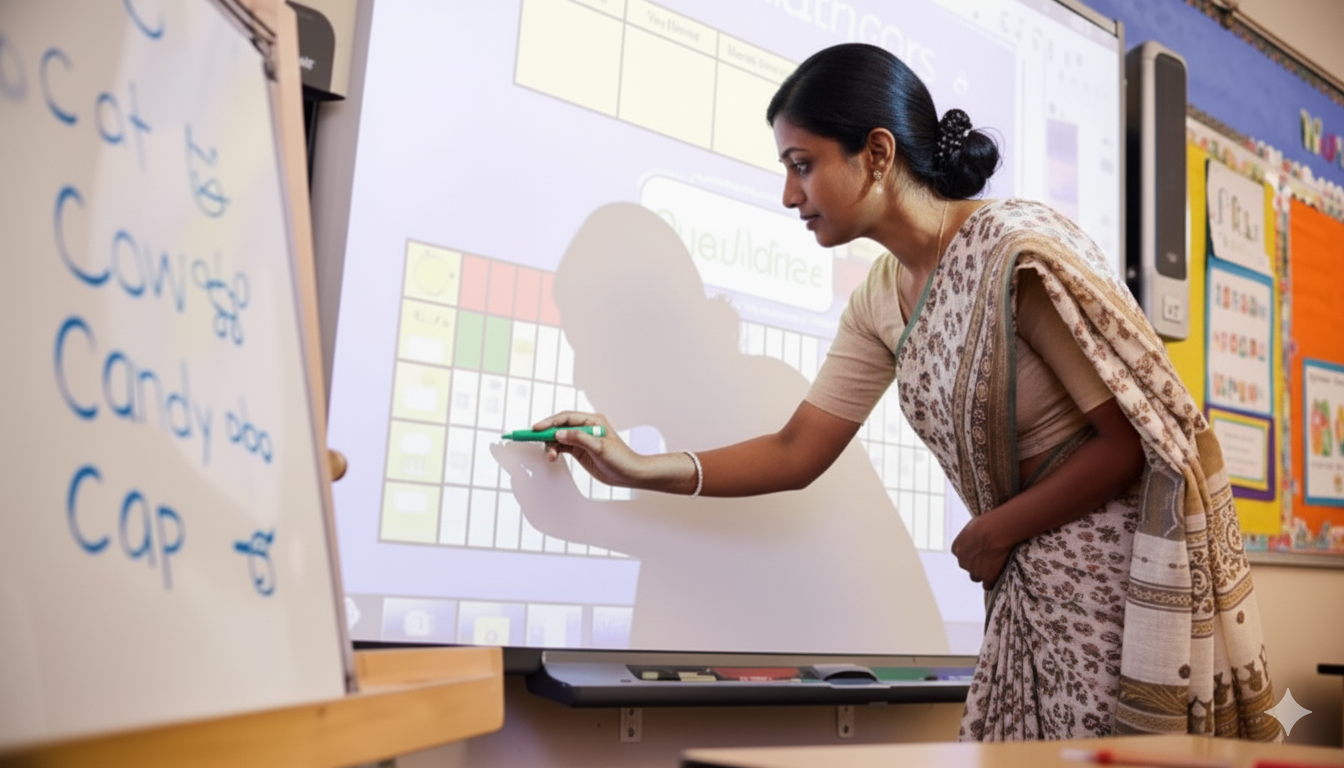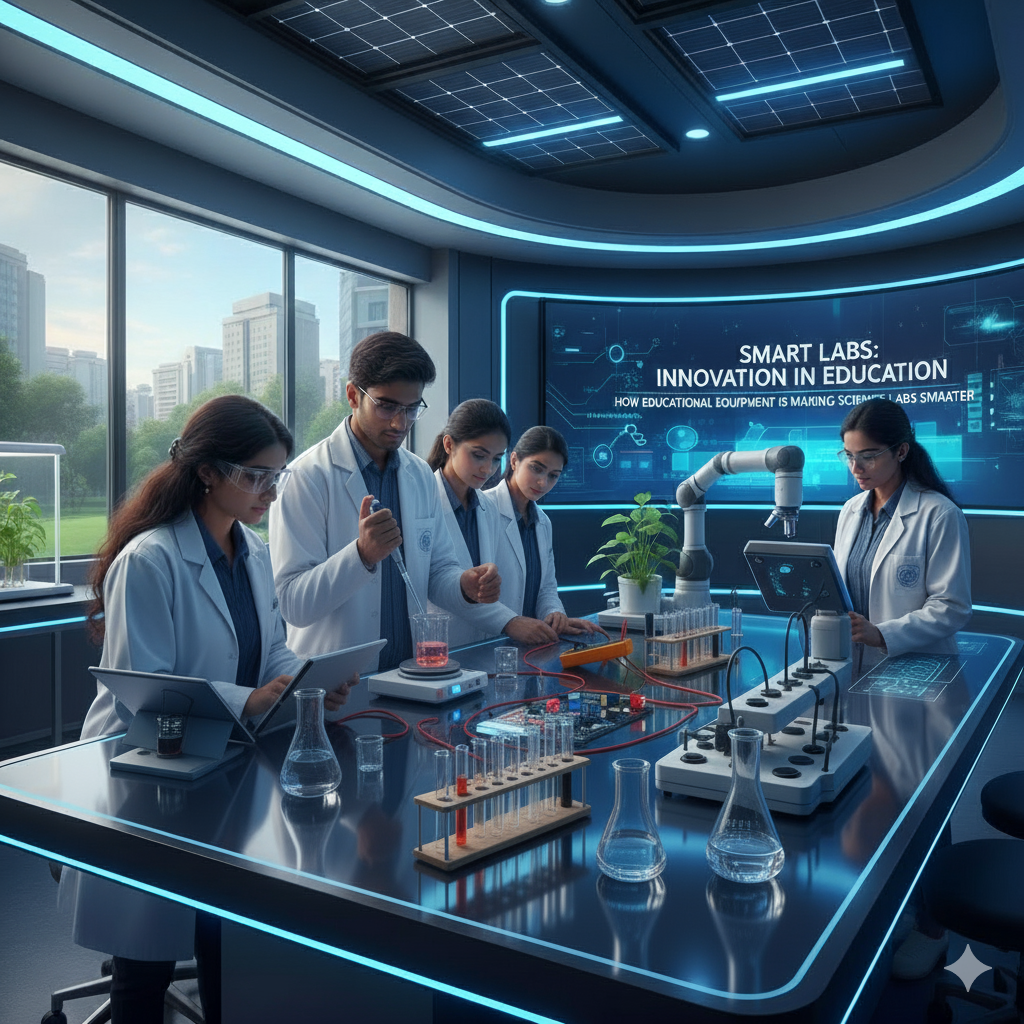Interactive Whiteboard: A Guide for Modern Indian Classrooms

Think back to your own school days. Can you hear the rhythmic scrape of chalk on a dusty blackboard? For generations, that was the sound of learning. It was a one-way street: the teacher at the front, lecturing, and students at their desks, listening. But the world has changed, and our classrooms are changing with it. India's National Education Policy (NEP) 2020 is pushing us toward a future that’s more dynamic, collaborative, and deeply integrated with technology.
At the heart of this educational revolution is the interactive whiteboard. It’s a piece of technology that’s completely reshaping the classroom, turning passive lessons into experiences students can touch and feel. But here’s where things get a bit confusing. The term "interactive whiteboard" often brings to mind the sleek, advanced touchscreens we see today, but that’s not the whole story.
Let's clear up the confusion. This guide will walk you through what a basic interactive whiteboard really is, how it has evolved, and the crucial pros and cons you need to weigh before bringing this game-changing tool into your school.
What is an Interactive Whiteboard? (And Why It's Not What You May Think)
When school administrators and teachers talk about getting an interactive whiteboard, they’re usually picturing a modern, all-in-one smart screen. While that’s what the term has come to mean, its roots lie in an older, more complicated technology that many schools are still grappling with. Knowing the difference between the two is the key to making a smart, future-proof decision for your students.
The Traditional Interactive Whiteboard: A Three-Part System
The original interactive whiteboard wasn't a single device at all. It was a team of three separate pieces of hardware that had to work together perfectly :
- The Computer: This was the brain, running all the software and holding the lesson content.
- The Digital Projector: This took the image from the computer screen and beamed it onto the whiteboard's surface for the class to see.
- The Touch-Sensitive Board: This looked like a standard whiteboard, but its surface could detect the touch of a special pen or a finger. It would then send that touch information back to the computer, which interpreted it as a mouse click or a pen stroke .
Getting this trio to sync up was a huge leap forward at the time, but as any teacher who has used one will tell you, it came with its fair share of technical headaches.
The Modern Solution: The All-in-One Interactive Flat Panel (IFP)

Fast forward to today, and the technology has evolved into something much simpler and more powerful: the Interactive Flat Panel (IFP). Think of it as a giant, brilliant tablet designed for the entire classroom . The stunning full HD display, the responsive touch screen, and the powerful built-in computer are all housed in one sleek, self-contained unit. It doesn't need a separate projector or computer to function. It’s a true plug-and-play solution that has rightfully become the new standard for modern classrooms.
The Evolution of the Interactive Whiteboard
The journey from that clunky, three-part system to the elegant flat panels of today wasn't an accident. It was powered by the technology we were all starting to use in our daily lives.
The first interactive whiteboards emerged in the early 1990s, pioneered by companies like Xerox PARC and SMART Technologies . Interestingly, they weren't built for schools at all. The original market was corporate boardrooms, meant to make business meetings more collaborative. It wasn't until the late '90s that educators saw the incredible potential for the classroom, and the technology began its slow but steady march into schools.
So, why the big change from projectors to panels? It all comes down to two major shifts in consumer electronics:
The Flat-Panel TV Revolution: Remember when flat-screen TVs went from a luxury item to a household staple? The massive global demand for thinner, lighter, and better-quality LCD screens drove innovation and brought down costs. This is the same technology that made it possible to build the large, crystal-clear displays at the heart of every modern IFP.
The Smartphone Touch Revolution: The launch of the smartphone changed our expectations for touchscreens forever. We got used to fluid, responsive, and accurate touch controls. This perfection of touch technology was the final piece of the puzzle, allowing interactive panels to offer the same intuitive experience we get from our phones, but on a classroom-sized scale.
In essence, a modern IFP is the brilliant child of a high resolution television and a high-end smartphone—a perfect fusion of technologies we already know and love.
The Pros and Cons of Traditional Interactive Whiteboards
For any school watching its budget, the lower sticker price of an older, projector-based system can look very appealing. But as many have learned the hard way, those initial savings often disappear, replaced by hidden costs and daily challenges that can disrupt the learning environment.
The Sole Advantage:
- Lower Initial Cost: Today, the main reason anyone considers a projector-based system today is that the upfront cost can be lower than a brand-new, all-in-one IFP.
The Overwhelming Disadvantages:
- Disruptive Shadows: Every teacher who has used a projector-based board knows the dreaded "shadow puppet show." The moment you step in front of the board to point something out, your shadow covers the lesson. It’s a constant, unavoidable disruption.
- Poor Image Quality: Projector images just can't compete with a modern screen. They often look dim and washed-out, especially in a brightly lit classroom. This frequently forces teachers to turn off the lights, which isn't ideal for students trying to take notes.
- High Maintenance and Hidden Costs: This is where the initial savings really start to hurt. Projector bulbs have a limited lifespan and are surprisingly expensive to replace. Add in the need for regular filter cleaning and higher energy bills, and the long-term cost of ownership often ends up being much higher than that of a modern panel.
- Constant Recalibration: If the projector or the board gets bumped even slightly, the touch points no longer line up with the image. This means stopping the class to run a tedious recalibration process—a surefire way to lose students' attention.
- Distracting Noise and Heat: Projectors have powerful fans to keep them from overheating. Those fans create a constant background hum that can be incredibly distracting in a quiet classroom. They also release a lot of heat, making the front of the room uncomfortable.
- Complex Installation: Setting up a projector system isn't a simple task. It involves precisely mounting two separate pieces of hardware and running a web of cables through walls and ceilings, an invasive and costly process.
Key Takeaway for Educational Institutions
When it comes to outfitting a modern classroom, understanding the difference between a traditional interactive whiteboard and an all-in-one interactive flat panel is everything. One is a relic of the past, and the other is the future of education.
A modern smart board for the classroom was designed specifically to eliminate all the frustrations of the older systems. It’s a smarter investment that delivers a far superior experience for teachers and students by offering:
- Brilliant, Shadow-Free Visuals: A crisp full HD screen that’s perfectly clear in any light, with no shadows to get in the way.
- Zero Ongoing Maintenance: No expensive bulbs to buy, no filters to clean, and no time-wasting calibration needed. This means a much lower total cost of ownership over the life of the device.
- Plug-and-Play Simplicity: It’s a single, self-contained unit that’s as easy to install as a TV, saving you time, money, and a lot of headaches.
- True Collaboration: With advanced multi-touch screens, multiple students can work on the board at the same time, turning learning into a team sport .
By choosing a modern IFP solution, you’re investing in a more reliable, engaging, and cost-effective tool that will empower your teachers and inspire your students for years to come.
Frequently Asked Questions
1. What is the main difference between an old interactive whiteboard and an IFP panel?
The biggest difference is that old interactive whiteboards are a three-part system needing a computer, a projector, and a board to work, which often causes shadows and requires lots of maintenance. New IFPs (often called new interactive whiteboards) are single, all-in-one devices with a built-in computer and a full HD screen, making them far simpler and better to use.
2. Are "smart boards" and "interactive whiteboards" the same thing?
Yes, in today's world, people use these terms to mean the same thing: a modern, all-in-one interactive screen. The term "interactive whiteboard" originally described the older projector-based models, but its meaning has updated along with the technology.
3. How do interactive boards for classrooms help students?
They make learning more exciting by letting students touch and interact with lessons directly, which helps all types of learners. They also encourage teamwork, as multiple students can use the multi-touch screen at once to solve problems together.
4. What is the average lifespan of a modern interactive flat panel?
A quality interactive flat panel is built to last, with a typical lifespan of around 50,000 hours of use. Unlike older systems, they don't have parts like projector bulbs that burn out and need to be replaced every couple of years.
5. Do we need a separate computer to use a modern smart board for the classroom?
No, you don't. A modern smart board for the classroom is a complete, standalone solution with its own built-in computer and operating system, like Windows or Android . This all-in-one design means it's ready to go right out of the box with minimal setup.
Step into the Future of Education with Roombr
Are you ready to leave the hassles of outdated technology behind and embrace a truly seamless digital classroom? The Roombr Digital Classroom is more than just an interactive display. It’s the world's first Walltop Computer, an all-in-one solution designed and patented to solve the real-world challenges faced by Indian educators.
Roombr brings together a state-of-the-art interactive display, a powerful Windows 11 computer, high-fidelity cameras, speakers, and microphones into one elegant unit. With simple plug-and-play functionality, any wall can become an immersive, collaborative learning hub. You can record live classes with AI-enhanced editing, share them with students for review, and track their progress with integrated assignments.
Trusted by institutions and certified by ISO and BIS, Roombr is built to empower teachers and prepare students for a digital-first world.
Explore the all-in-one Roombr Digital Classroom solution here.
Foziya Abuwala
Share
Step Into the future of
Education with Roombr

















